"Cityscape" is a very broad term that most of the time refers not only to a certain place, but also to a place we have experienced, are familiar with and have left deep memories. It may be obvious to everyone, or it may be a secret that only you know.
Memories are raging, and the authors are calm, sincere, and honest. We hope to take you on a journey through each of the interesting and extraordinary cityscapes in our "City Walk Guide" series.
preamble
When I was young, I had an "out-of-this-world" mentality and aspired to live a secluded and solitary life. As I grew older, I realized the social nature of human beings, that they are social creatures and cannot exist apart from society. So, my thinking gradually changed and I moved closer to the "world", in my own words, trying to "connect deeply with the world". Therefore, "travel" has some kind of extraordinary meaning to me. Unlike many people's view of travel, I believe that the act of travel should have deeper humanistic attributes than the physical characteristics of time and space shift and the consumerist tendencies created by the industry.
Listen to a story, feel a style, experience a life.
In early 2020, on the eve of the first outbreak of the global New Guinea epidemic in Wuhan, I travelled with my mother to visit my family in Singapore, where my grandparents and my uncle were staying. According to Singapore's immigration policy, I was only allowed to stay for one month, but it was extended for an unexpected and special period.
Singapore is a city and a country. As a country of only 6 million people, it is no exaggeration to call it a "small country", but it is a jewel in Asia and the world because of its unique location. And this journey begins at a special time in a special place.
Nanyang Technological University NTU
📍 Location: 50 Nanyang Ave, Singapore 639798
Transportation: Take the SMRT East-West Line (EW Line) to the Boon Lay bus interchange and transfer to bus 179 or 199 for direct access to the campus.
🔗 Official website: www.ntu.edu.sg
In the summer of 2013, I came here for a short stay during my high school holidays, and I had to pass by this gate on my way to pick up my cousin from kindergarten every afternoon. Now, however, the place is full of flowers and carved beams, not at all like what it was then.
This Republican-style gate is the main entrance of Nanyang Technological University (https://zh.wikipedia.org/wiki/南洋大学), the predecessor of Nanyang Technological University (NTU), which was established in 1955. Located in Jurong West, Nanyang Technological University is one of Singapore's most prestigious institutions, and the ruins of its predecessor offer a glimpse of the human face of that era.
A short walk through the gate, you can see another preserved building, the monument of Nanyang University. It has a square shape, with the same navy blue eaves as the gate, and no elaborate decorations except for a few back-shaped clouds, as if it were a learned old man in a Zhongshan suit, with a very neutral and competent taste.
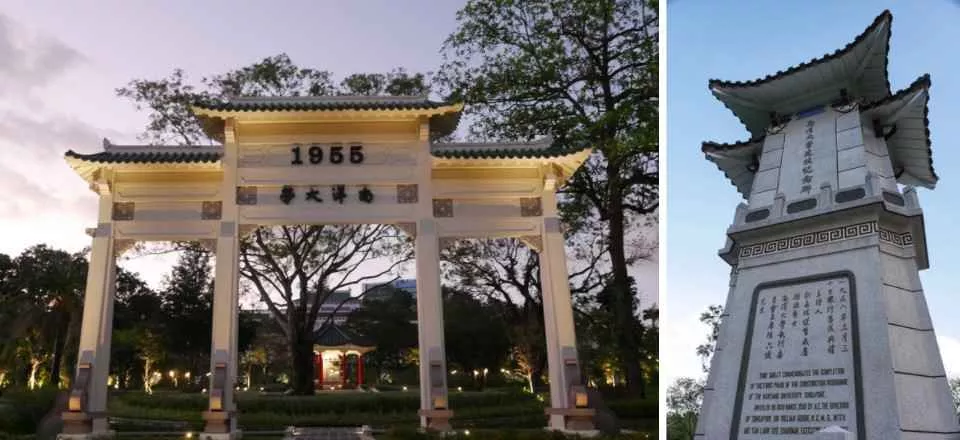 南洋大学校门及建校纪念碑### 云南园 Yunnan Garden
南洋大学校门及建校纪念碑### 云南园 Yunnan Garden
The Nanyang Technological University (NTU) gates and founding monuments mentioned above are part of the Nanyang Technological University (NTU) Yunnan Garden, which will be reopened in mid-February 2020 after 20 months of redevelopment. Broadly speaking, the entire Nanyang Technological University site is known as 'Yunnan Garden', and narrowly speaking, it refers specifically to this nine-hectare garden. The Yunnan Garden is an iconic heritage site of Nanyang Technological University, known for its lush landscape and waveform topography. At a time when the epidemic had not yet reached Singapore, the rebuilt Yunnan Garden attracted many visitors to the site, with a steady stream of people coming and going.
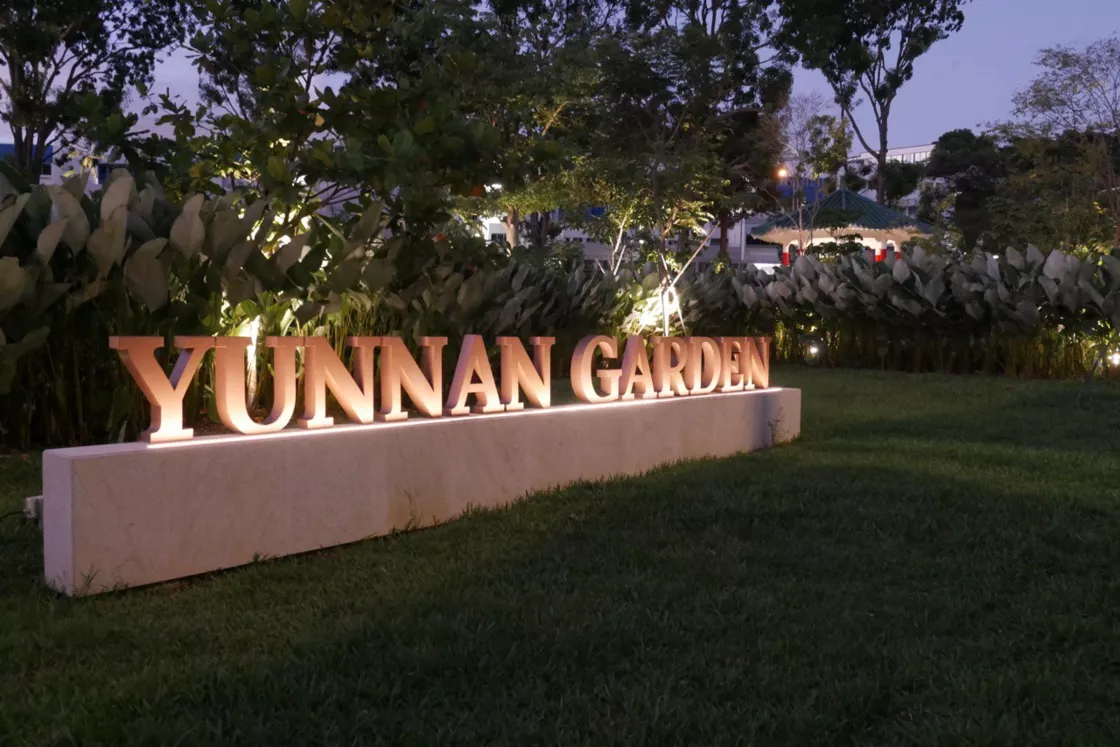 Yunnan Garden
Yunnan Garden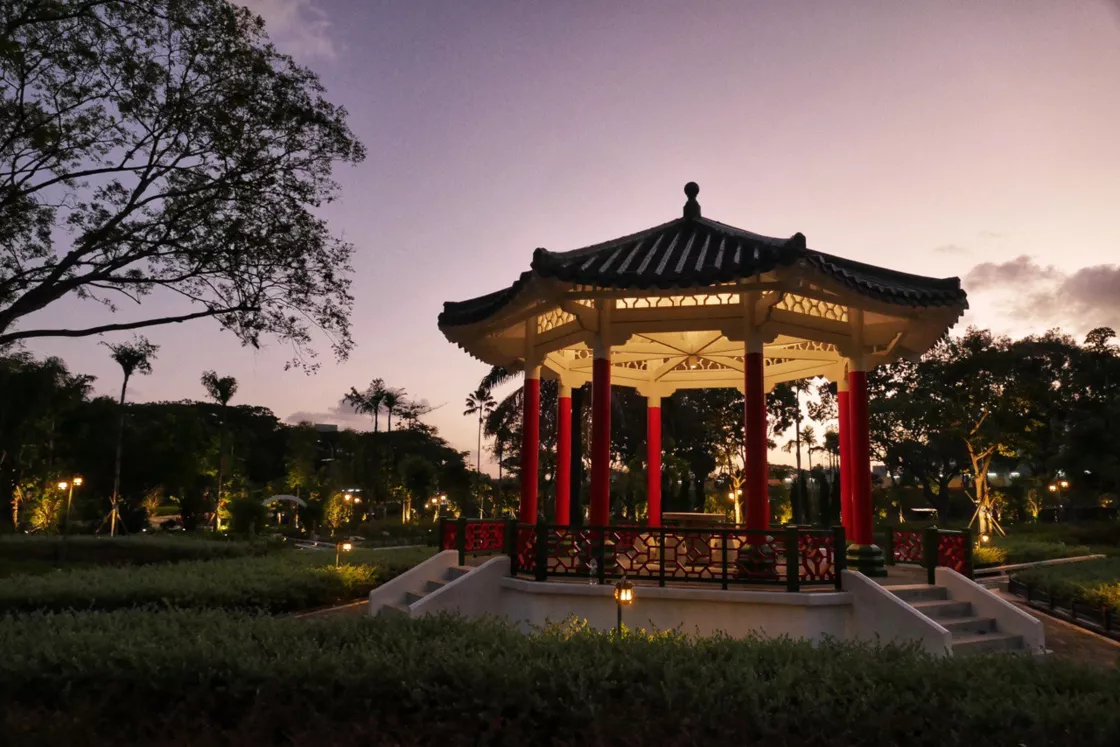 A pavilion in the Yunnan Garden
A pavilion in the Yunnan Garden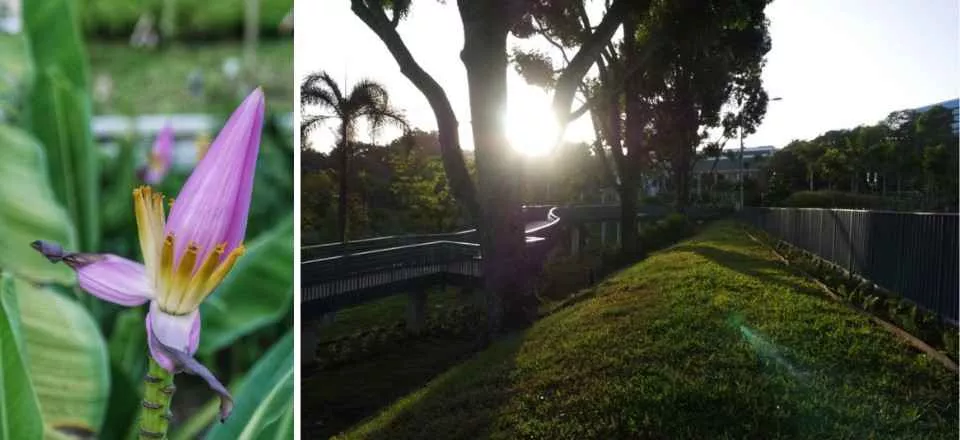 Yunnan Garden Inside Yunnan Garden More than 1,000 trees of nearly 80 species have been planted in Yunnan Garden, enriching its biodiversity.
Yunnan Garden Inside Yunnan Garden More than 1,000 trees of nearly 80 species have been planted in Yunnan Garden, enriching its biodiversity.
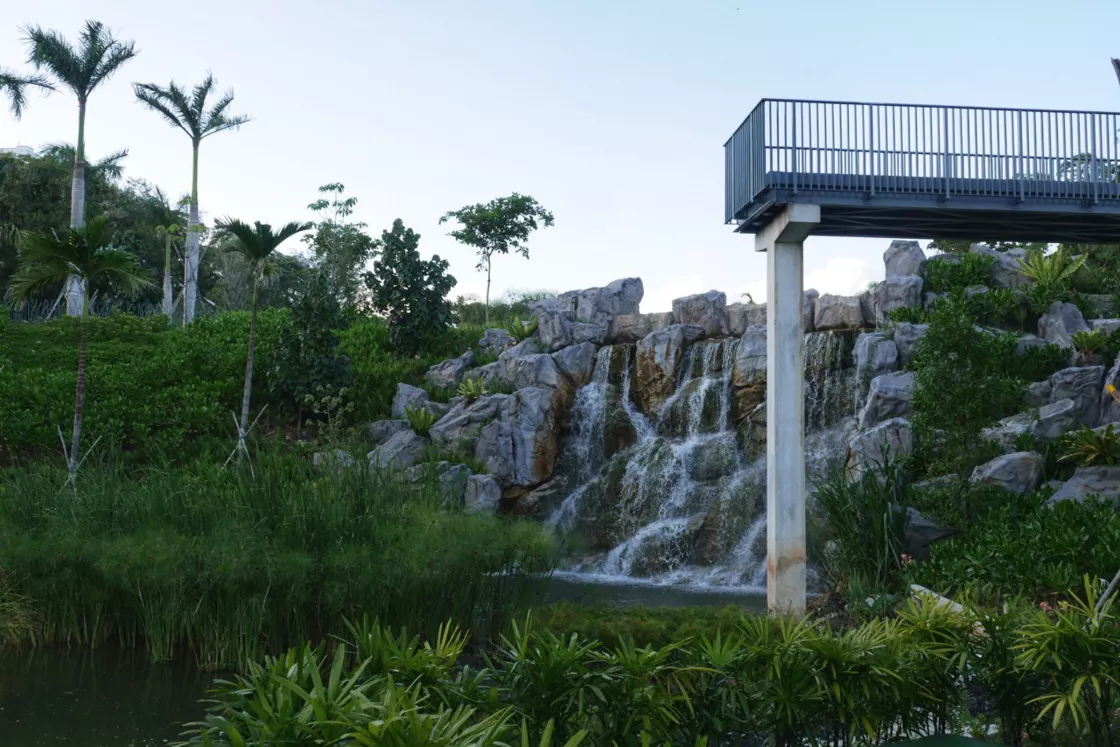 Artificial waterfall that connects Yunnan Garden to Nanda LakeThe upper end of Yunnan Garden connects to Nanda Lake, where the top-down water flow causes the otherwise sedate lake to flow, and then through A nearly six-meter-high artificial waterfall distributes the lake's water into eight small ponds in the park.
Artificial waterfall that connects Yunnan Garden to Nanda LakeThe upper end of Yunnan Garden connects to Nanda Lake, where the top-down water flow causes the otherwise sedate lake to flow, and then through A nearly six-meter-high artificial waterfall distributes the lake's water into eight small ponds in the park.
South Grand Lake
Nantah Lake, formerly known as Nantah Lake and later renamed Nanyang Lake, was reconstructed to connect with and become part of the Yunnan Garden. Strolling along the lake, paths are lined with orchids and other flowers and herbs. In a hidden spot that is rarely noticed by visitors, there is a complete rainwater management system built across the entire Yunnan Garden based on Nanyang Lake. The water from the lake eventually flows through drains and canals into a cistern and is purified to ensure clean water.
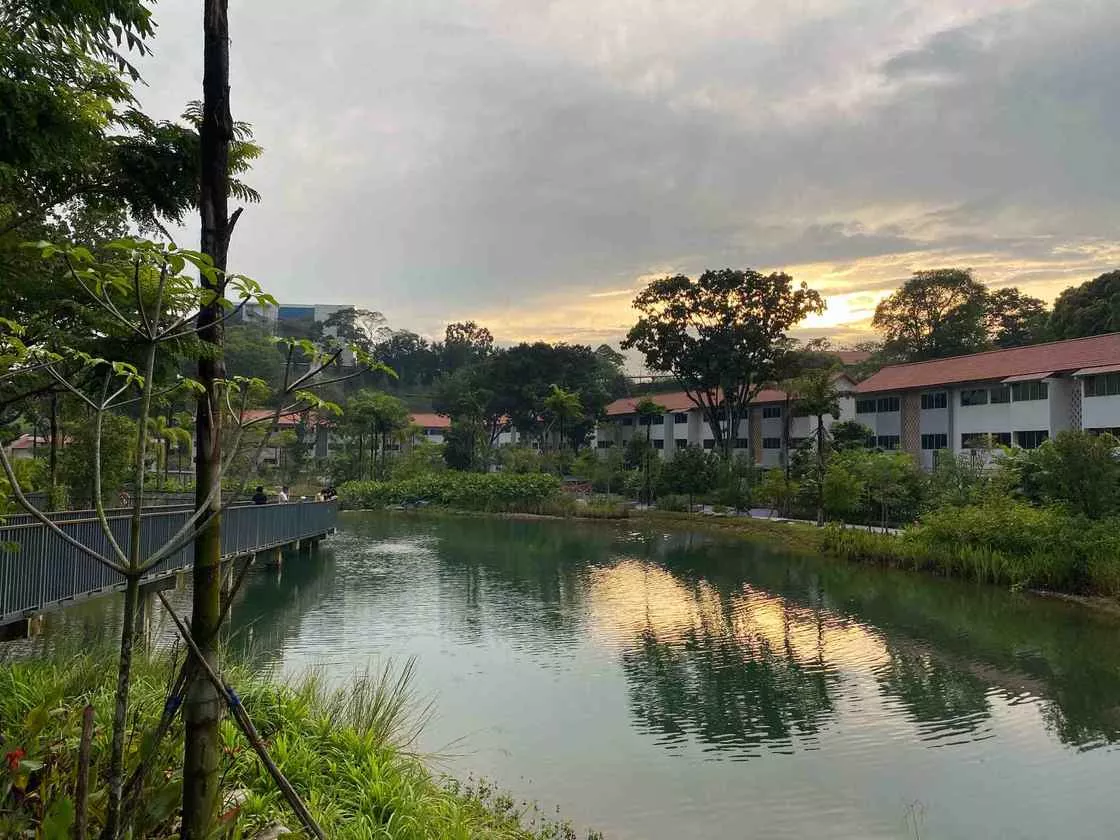 South Grand Lake### Chinese Pavilion
South Grand Lake### Chinese Pavilion
📍 Location: 12 Nanyang Drive, Singapore 637721
Opening hours: Monday to Friday: 9:30am to 5:00pm; Saturday and Sunday: 10:00am to 5:00pm; last admission at 4:30pm; closed on public holidays
Located on the Nanyang Technological University (NTU) campus, the 560 sqm Nanyang University Administration Building, built in 1953, was officially declared a National Monument in 1999. Today, the Chinese House is not only a museum with many permanent exhibits, but also a research centre focusing on overseas Chinese issues, playing a unique role as a bridge between the university and the community, and playing a unique role in overseas Chinese identity. The Nanyang Drive between the Chinese-American Museum and the old Yunnan Garden is now the Old Nanyang Drive. The redevelopment project has transformed it into part of the plaza outside the Chinese Pavilion, making the Yunnan Garden and the Chinese Pavilion into one new cultural heritage landscape on campus.
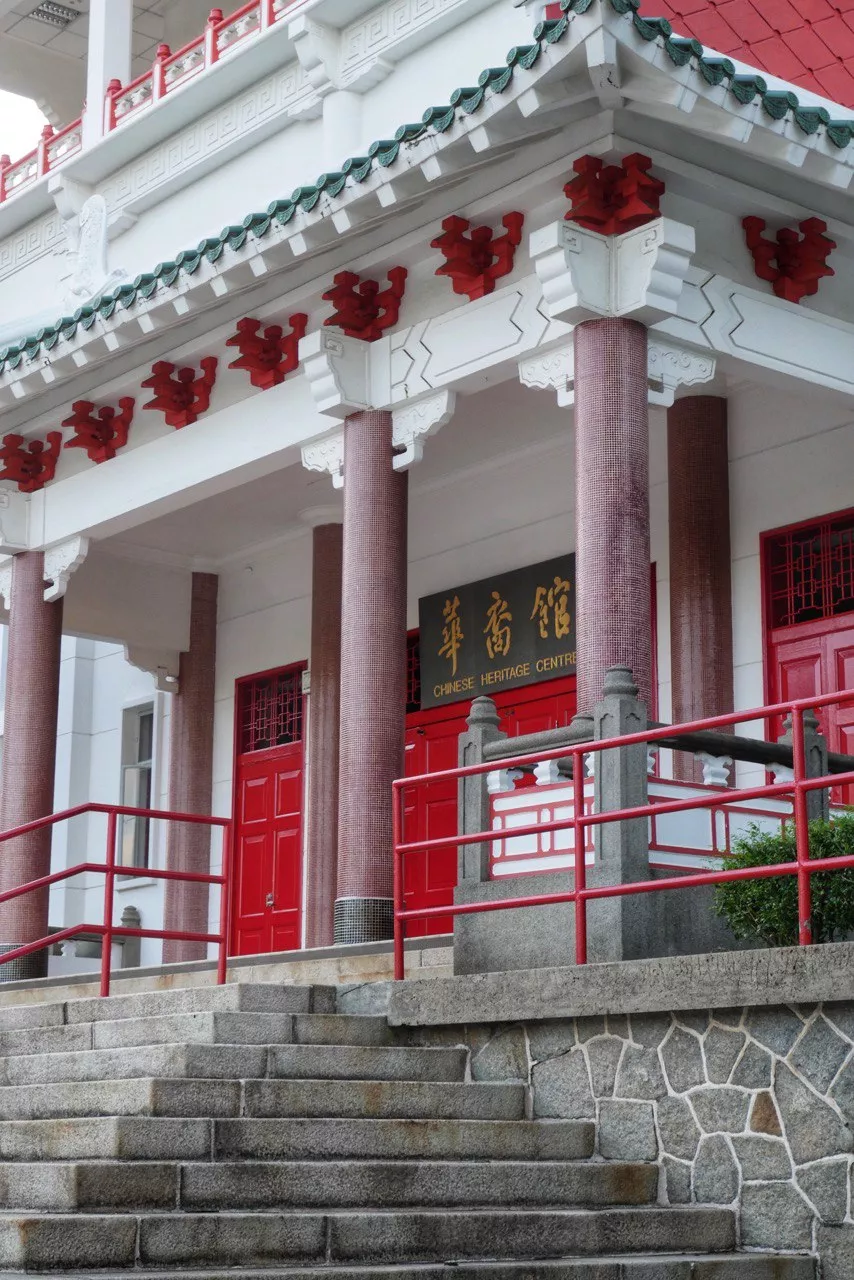 Chinese-American Pavilion### The Hive The Hive
Chinese-American Pavilion### The Hive The Hive
📍 Location: 52 Nanyang Drive, Singapore 637721
The Hive, also known as the Learning Hub South, designed by British architect Thomas Heatherwick and completed in 2015, is one of the landmarks on the Nanyang Technological University campus. The building consists of 12 eight-storey towers arranged around a public atrium. The towers taper down towards the bottom and can accommodate 56 cornerless classrooms. It is also often referred to by locals as the "Xiao Long Bao" or "Dim Sum Tower" due to its resemblance to the steamer used to hold dim sum.
 The exterior of the Hive / Source: Internet From the outside, it looks like a very "wrapping" building, with a facade that completely breaks the conventional design concept and the vines that fill The exterior walls and the vines that fill it give me a feeling of being tightly surrounded. Inside, however, it is not stuffy, and can even be described as cool and airy, thanks to a specially designed ventilation system that allows the air inside and outside the tower to circulate well.
The exterior of the Hive / Source: Internet From the outside, it looks like a very "wrapping" building, with a facade that completely breaks the conventional design concept and the vines that fill The exterior walls and the vines that fill it give me a feeling of being tightly surrounded. Inside, however, it is not stuffy, and can even be described as cool and airy, thanks to a specially designed ventilation system that allows the air inside and outside the tower to circulate well.
 Inside the HiveThe Hive, though distinctive in design, is a solid learning center, with a lobby on the ground floor with a lounge area and small shop. Looking up, cascading corridor enclosures outside cornerless classrooms fill the entire vertical space. Upstairs, strolling down the corridors, you can catch glimpses of students everywhere, in twos and threes, discussing, studying or asking tutors for advice in the glass-constructed classrooms. This is exactly what the school wanted when it came to creating a dynamic learning environment for interaction anywhere, anytime.
Inside the HiveThe Hive, though distinctive in design, is a solid learning center, with a lobby on the ground floor with a lounge area and small shop. Looking up, cascading corridor enclosures outside cornerless classrooms fill the entire vertical space. Upstairs, strolling down the corridors, you can catch glimpses of students everywhere, in twos and threes, discussing, studying or asking tutors for advice in the glass-constructed classrooms. This is exactly what the school wanted when it came to creating a dynamic learning environment for interaction anywhere, anytime.
Continuing forward, the walls of the aisle undulate in a wave-like pattern, with intricate reliefs. At the end of the corridor is a circular balcony, wrapped by a shoulder-high wall on the periphery, on which small shrubs and flowers that cannot be named are planted, and through the gaps in the foliage, the shutter is casually pressed: the
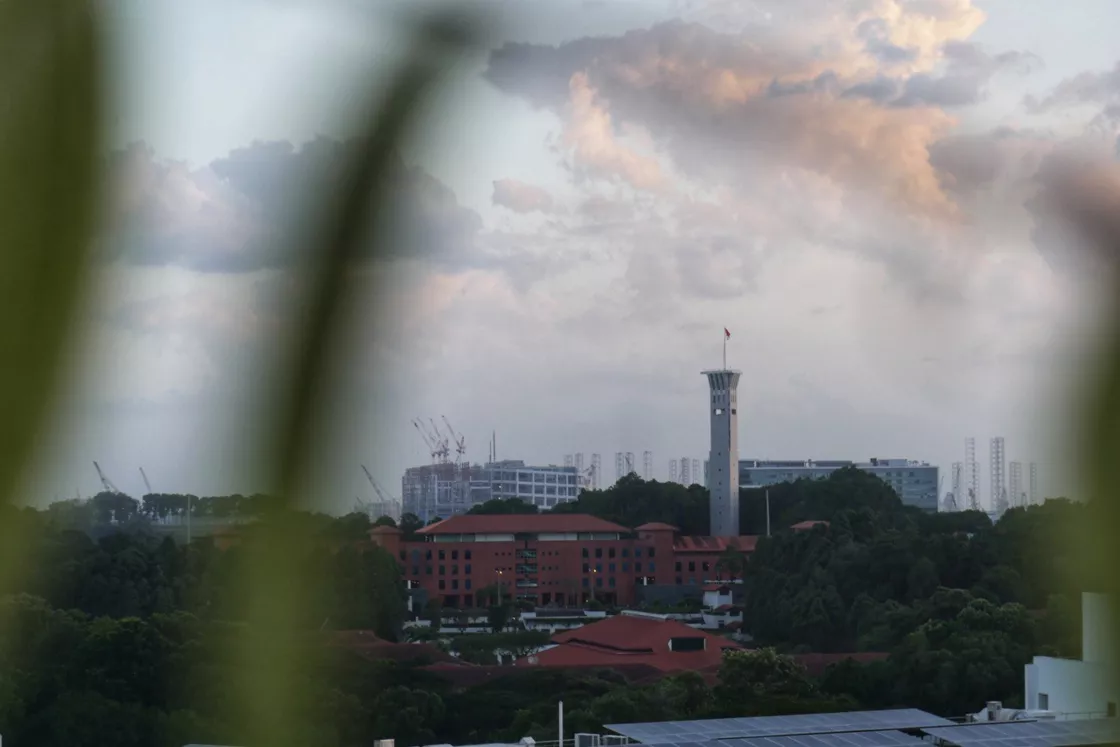 A distant view inside the HiveThe Hive conveys to me an idea from the inside out: creating a "borderless" environment with a "tangible" design. Its various details reveal an open and inclusive message. I think this is a good example of how external forms can influence the behavior of students and faculty, and thus integrate into the campus culture.
A distant view inside the HiveThe Hive conveys to me an idea from the inside out: creating a "borderless" environment with a "tangible" design. Its various details reveal an open and inclusive message. I think this is a good example of how external forms can influence the behavior of students and faculty, and thus integrate into the campus culture.
The School of Art, Design and Media
📍 Location: 81 Nanyang Drive, Singapore 637458
The architecture of the School of Art, Design and Media building at Nanyang Technological University is unique in that the whole building looks like two crescents from the sky, and the most representative feature is the curved roof lawn. It was late in the day, and with the temporary fence erected on the outside, I was unable to step on it, which was a pity.
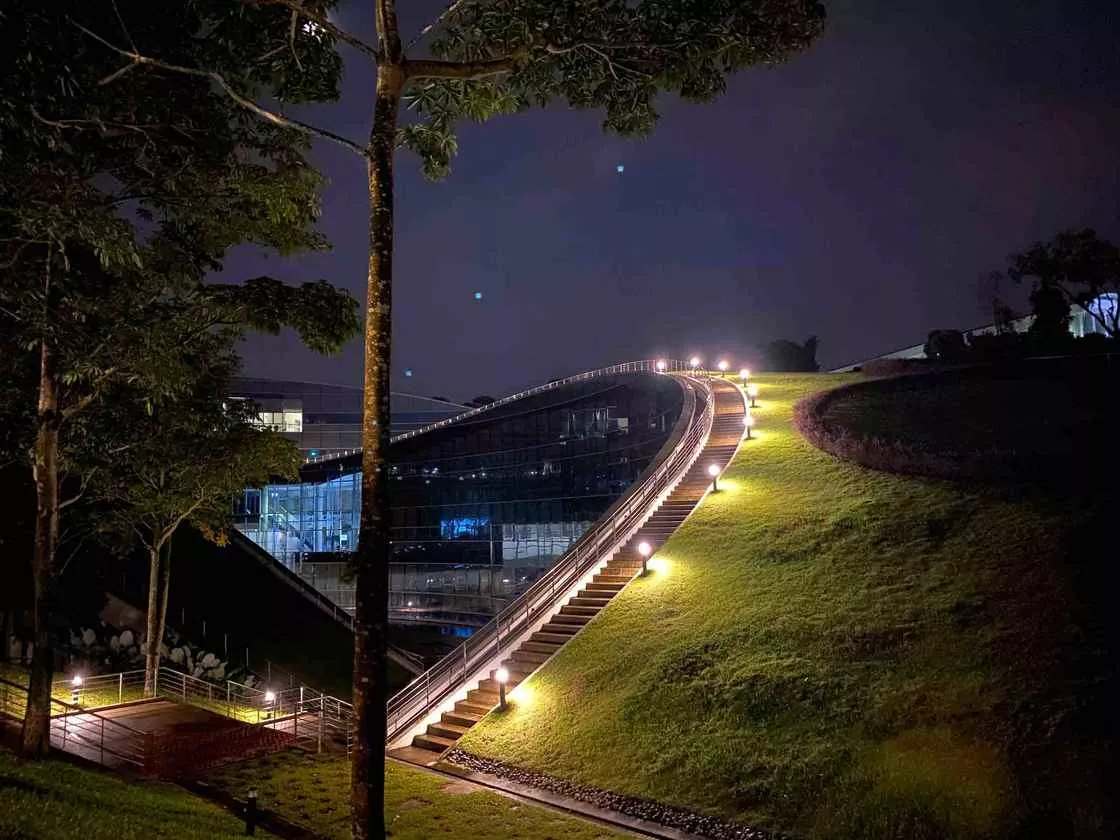 School of Art, Design and Media -
School of Art, Design and Media -
Henderson Waves Pedestrian Bridge Henderson Waves
📍位置:Henderson Road, Singapore 159557
One early morning after the city closure in Singapore was lifted, I headed out for a long-planned hike to the Henderson Wave footbridge near Telok Blangah Hill. This area has less traffic and the road is clear and less cornered, but has many ups and downs in elevation.
Henderson Waves is a 36m above ground wavy footbridge, 274m long, connecting Telok Blangah Hill Park (Telok) with Mount Faber Park (Mount Faber Park), which has a unique and nature-inspired design. Incidentally, the two parks that are connected are also well worth a visit.
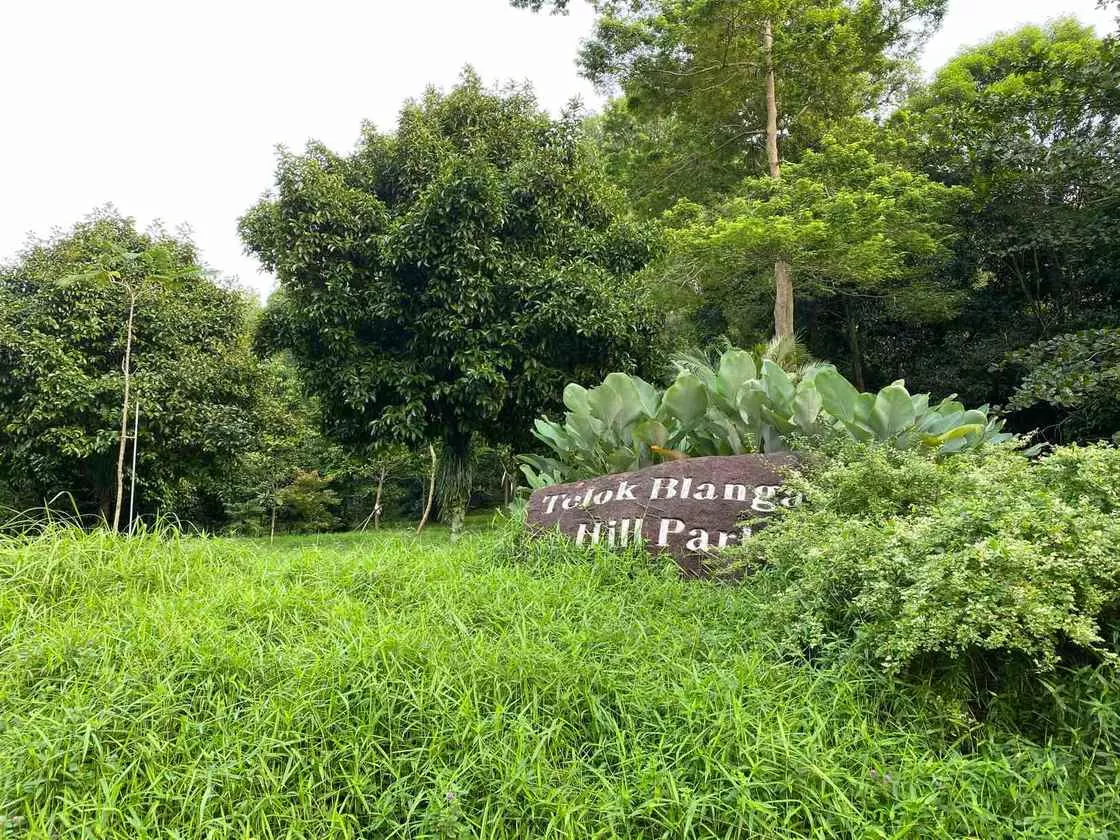 Straight Down Blangah Mountain ParkWhile traveling here, I happened to meet a very talkative running uncle at the turnoff, and as a local with a southern Minnesota accent, he enthusiastically gave me an overview of Straight Down Blangah Mountain Park and the Henderson Wave Pedestrian Bridge. He gave me an overview of the Telok Blangah Mountain Park and the Henderson Wave Pedestrian Bridge, and highly recommended a trail through the Southern Ridge. The Southern Ridges Trail is a hike through the Southern Ridges ().
Straight Down Blangah Mountain ParkWhile traveling here, I happened to meet a very talkative running uncle at the turnoff, and as a local with a southern Minnesota accent, he enthusiastically gave me an overview of Straight Down Blangah Mountain Park and the Henderson Wave Pedestrian Bridge. He gave me an overview of the Telok Blangah Mountain Park and the Henderson Wave Pedestrian Bridge, and highly recommended a trail through the Southern Ridge. The Southern Ridges Trail is a hike through the Southern Ridges ().
 Henderson Wave Pedestrian Bridge Vision / Source:Felix Fuchs / Unsplash
Henderson Wave Pedestrian Bridge Vision / Source:Felix Fuchs / Unsplash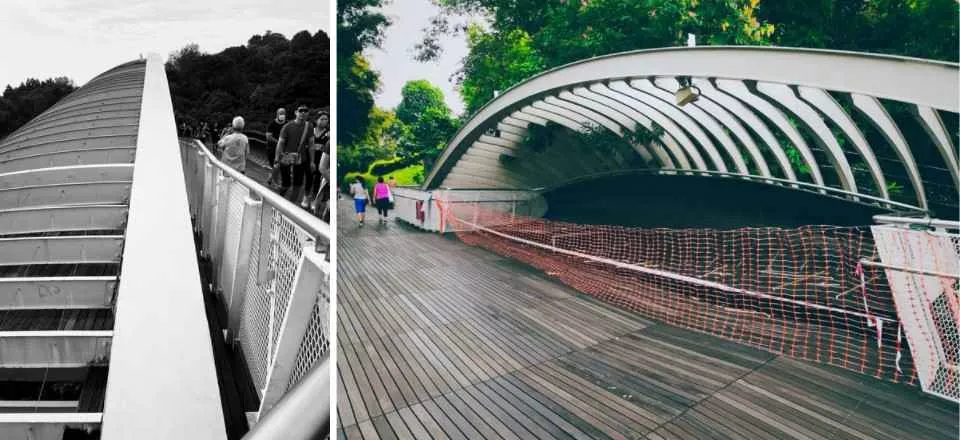 The bridgeAfter over two hours of trekking, I finally picked up the steps to the top of the bridge. As I walked up, I could see the wavy "keel" on one side as a support, which should be a steel structure painted in white, while the bridge deck is made of balau wood, a hard wood unique to Southeast Asia, with several hidden and shell-like resting areas. Unfortunately, the resting areas on the bridge and at the bridge head are fenced off to prevent crowds from gathering due to the epidemic prevention policy, otherwise it would be a pleasure to sit and enjoy the surrounding scenery.
The bridgeAfter over two hours of trekking, I finally picked up the steps to the top of the bridge. As I walked up, I could see the wavy "keel" on one side as a support, which should be a steel structure painted in white, while the bridge deck is made of balau wood, a hard wood unique to Southeast Asia, with several hidden and shell-like resting areas. Unfortunately, the resting areas on the bridge and at the bridge head are fenced off to prevent crowds from gathering due to the epidemic prevention policy, otherwise it would be a pleasure to sit and enjoy the surrounding scenery.
Marina Bay
📍 Location: 11 Marina Boulevard, Singapore 018940
Transportation: Take the SMRT Circle Line or Downtown Line to Bayfront Station and follow Bayfront Ave.
A month before I was due to return home, I thought that I had yet to visit some of the most famous areas in Singapore, so I took the time to pack my bags. Marina Bay is the result of Singapore's land reclamation project, which only started in the 1970s, but the development of this area in just a few decades is a miracle, and has become synonymous with modernity and style.
Marina Bay Sands
📍 Location: 10 Bayfront Ave, Singapore 018956
🔗 Official website: www.marinabaysands.com
Once you get off the subway and head down Bayfront Ave towards the beach, you can see the Sands Hotel far ahead. Yes, it's the same location that was featured in the theatrical version of Detective Conan: Cyanide's Fist. The Marina Bay Sands is Singapore's famous integrated resort, housing a hotel, convention centre with exhibition facilities, theatre with a casino, shopping mall and several restaurants, and is famous for its infinity pool in the sky garden on the top floor. Its Marina side is situated with places to go such as the ArtScience Museum, Marina Bay Gardens, and shopping malls.
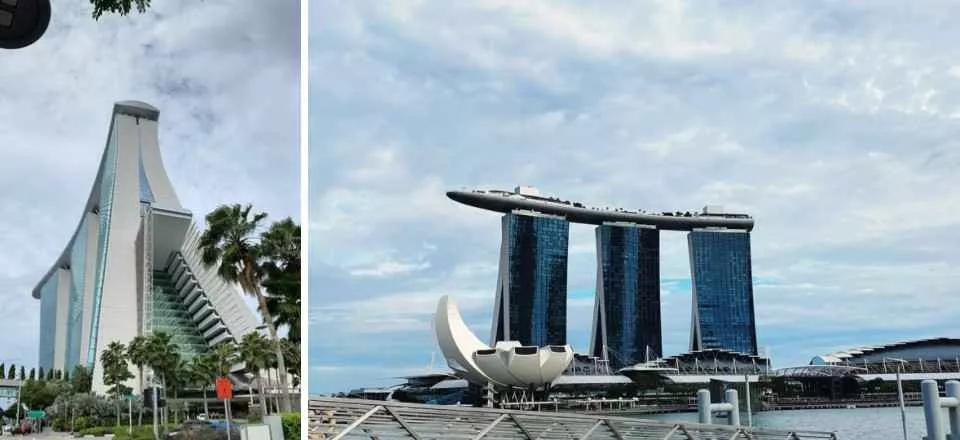 Marina Bay Sands Hotel### ArtScience Museum
Marina Bay Sands Hotel### ArtScience Museum
📍 Location: 6 Bayfront Ave, Singapore 018974
Opening hours: 10:00 am to 7:00 pm daily, including public holidays. The latest admission time is 6:00 p.m.
Just past the entrance of the Sands Hotel and continuing on, another landmark building, the ArtScience Museum, is on the left. The ArtScience Museum is a unique modern flower-shaped building designed by Canadian architect Moshe Safdie as one of the attractions of Marina Bay Sands, hosting mainly travelling exhibitions curated by other museums. With the epidemic still raging and this museum closed, I could only admire its look from the outside.
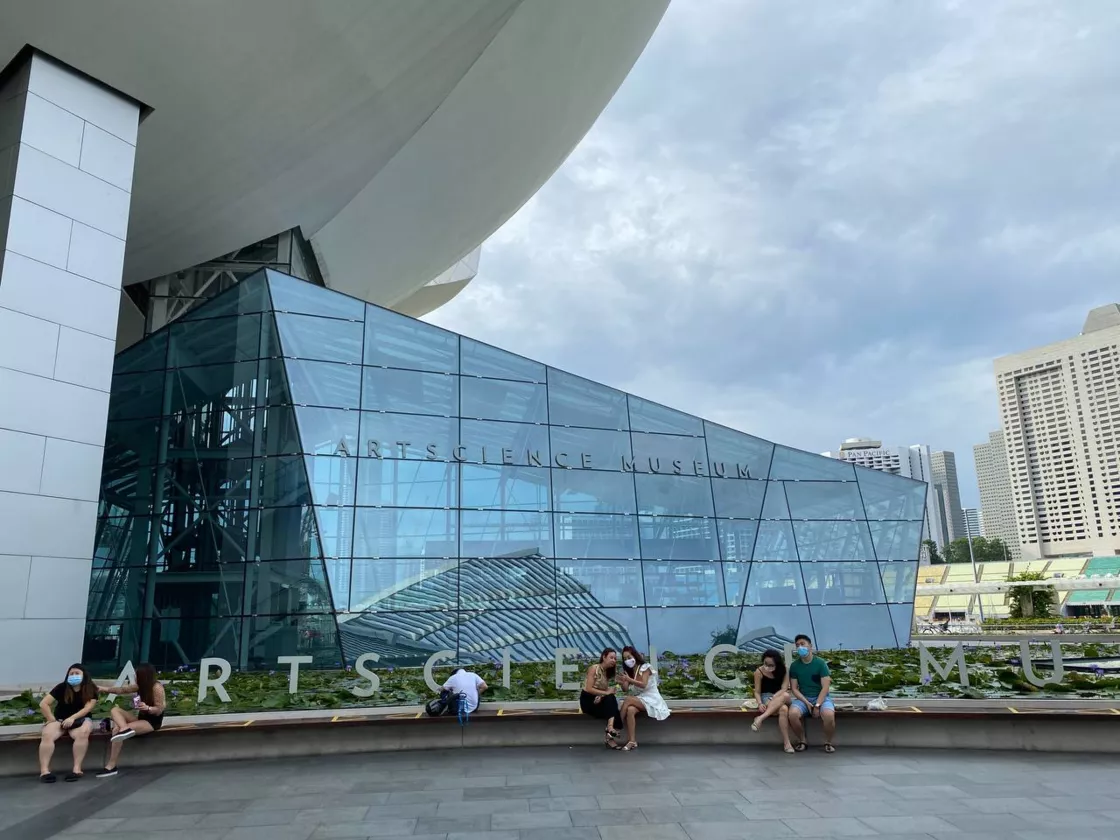 ArtScienceMuseum### Helix Bridge
ArtScienceMuseum### Helix Bridge
Opened in 2010, the Spiral Bridge is a steel pedestrian bridge spanning both sides of the bay, inspired by the spiral structure of DNA. Its roofless design makes it a little sultry on sunny days, while the side near the shore features several circular observation decks, perfectly positioned to capture the Marina Bay scenery.
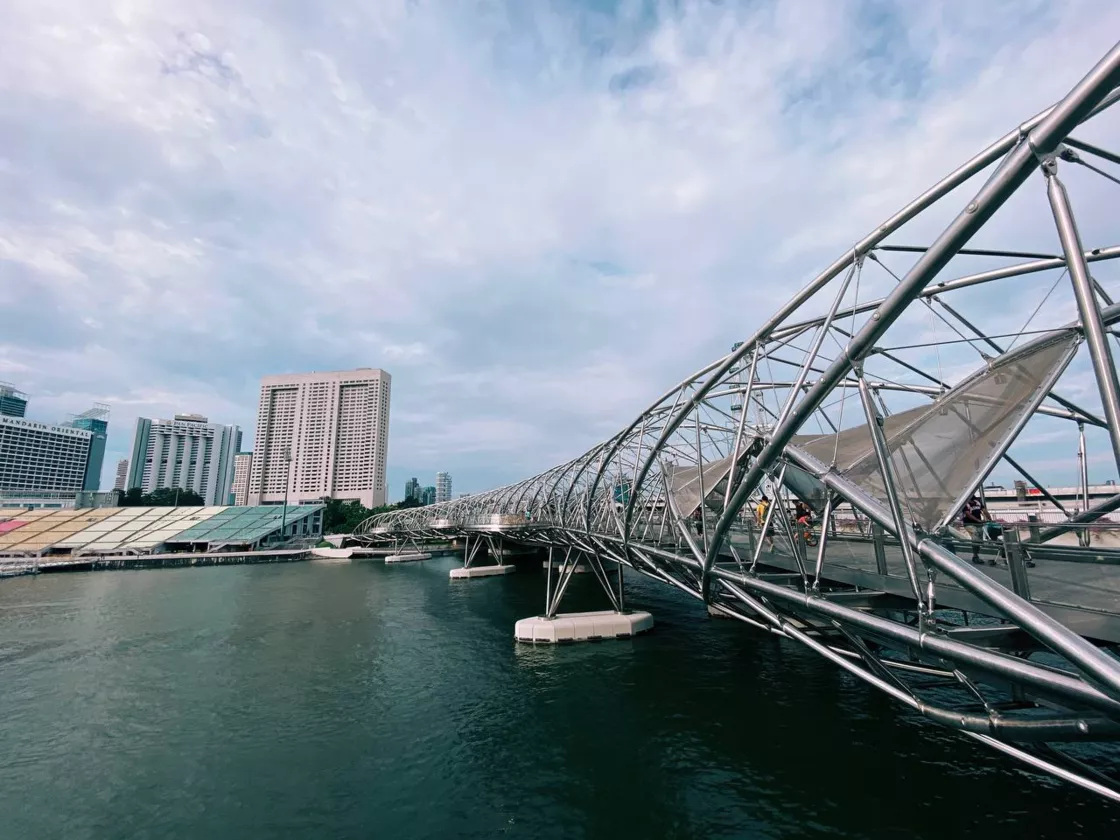 Spiral Bridge### Fishtail Park Merlion Park
Spiral Bridge### Fishtail Park Merlion Park
Yes, it's also a park, and Fishtail Lion Park is the smallest park in Singapore, located next to Fulton Hotel, covering 0.25 hectares, with an open terrace that makes it easy for visitors to take photos in front of the Fishtail Lion. The fishtail lion (Merlion) is a fictional fish-bodied, lion-headed animal. It was designed in 1964 by Fraser Brunner, then curator of the Van Kleef Aquarium, to combine history and culture. Two years later it was adopted by the Singapore Tourism Board as its logo, which was used until 1997. In the meantime, the Fishtail Lion has become a symbol of Singapore, like the Tower of Paris in France or the Statue of Liberty in the United States.
At any time of the day, there are always tourists in Fishtail Park, and sometimes there are street performers here, either playing or singing a song or showing off their dance moves. I also met an old man dressed as a western cowboy, riding his bike with his favorite song playing on the car stereo, his silver hair and his goofy face were very interesting.
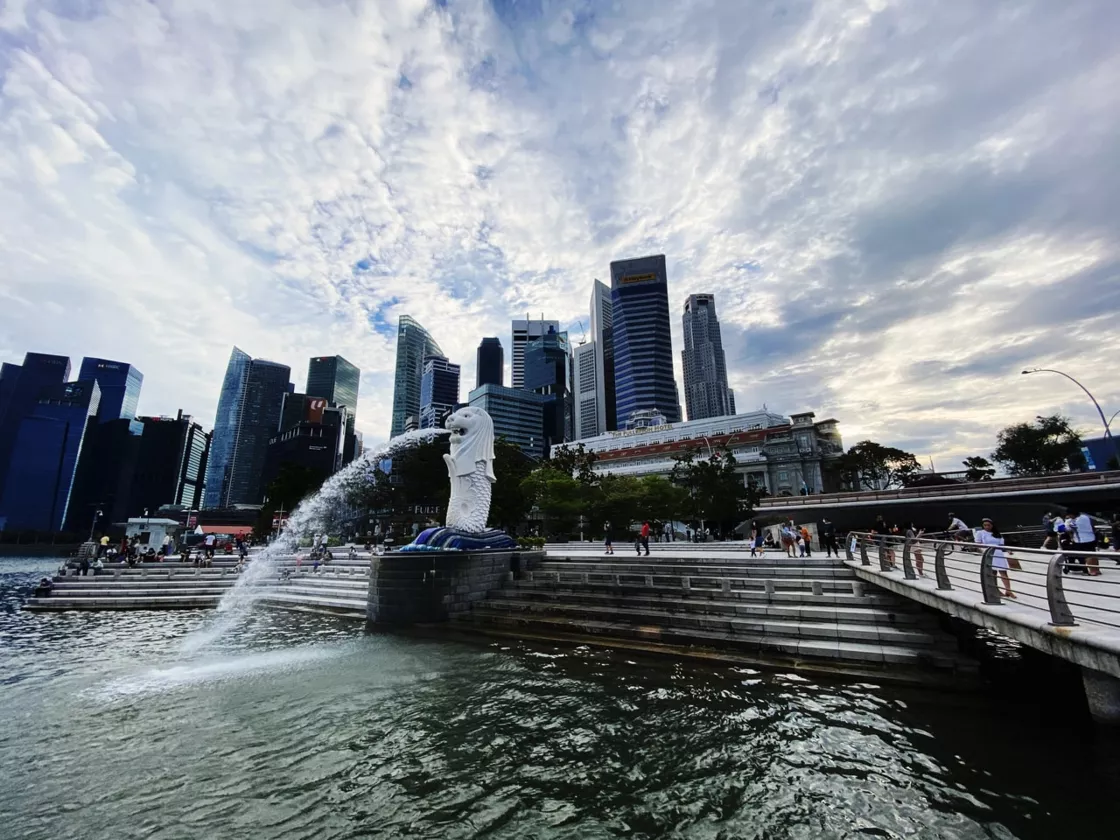 Fishtail Lion Park### Marina Bay Sands Garden Park
Fishtail Lion Park### Marina Bay Sands Garden Park
It was getting late and I had finished my Marina Bay tour, so it was time to check out the Marina Bay Gardens at night. Marina Bay Gardens is a 101-hectare park in the middle of Singapore's Marina Bay, completed in 2012, built on reclaimed land adjacent to the Marina Reservoir, and is known for its nightly light show. Unfortunately, the iPhone 11 Pro's imaging in low light conditions no longer supports the shot, so I've put together a webcam picture.
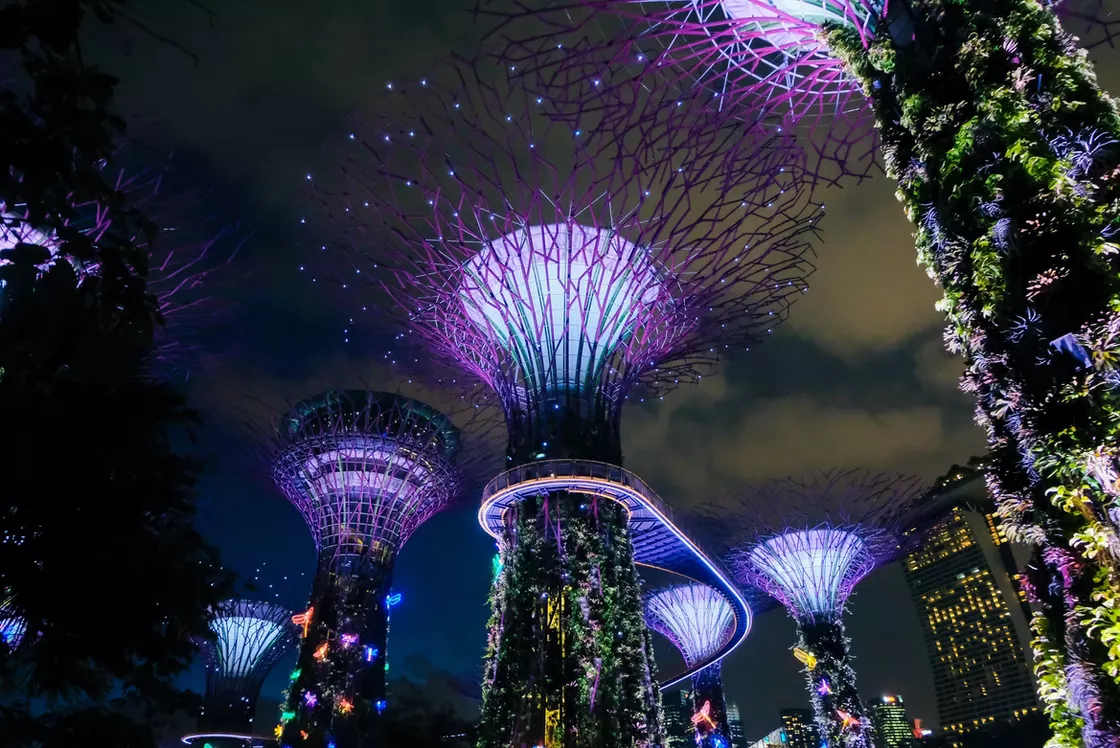 Marina Bay Gardens / Source: Miguel Sousa / Unsplash
Marina Bay Gardens / Source: Miguel Sousa / Unsplash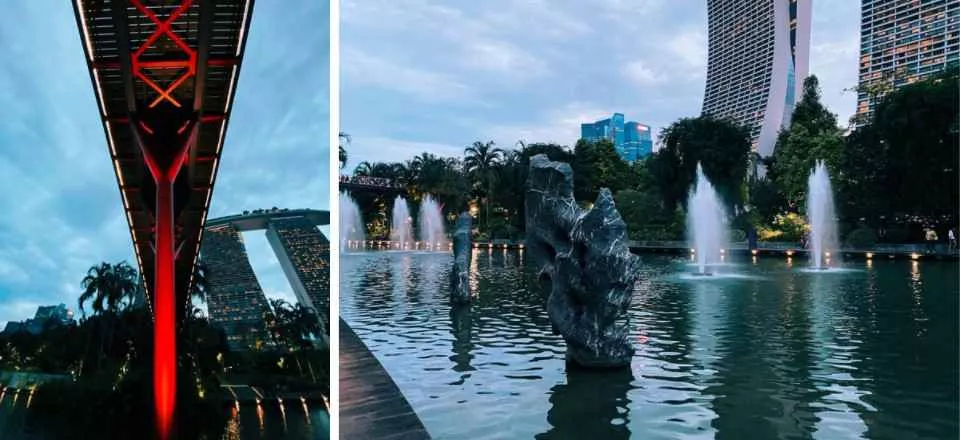 Marina Bay Gardens CornerThe interior of Marina Bay Gardens features a number of towering 'Corolla Trees', which are brightly lit at night. I queued up for the lift to the pedestrian walkway attached to the trees, which had a dreamy feel as the lavender lights from the canopy poured down against the colourful star dots on the trees and the ground.
Marina Bay Gardens CornerThe interior of Marina Bay Gardens features a number of towering 'Corolla Trees', which are brightly lit at night. I queued up for the lift to the pedestrian walkway attached to the trees, which had a dreamy feel as the lavender lights from the canopy poured down against the colourful star dots on the trees and the ground.
Apple Marina Bay Sands
📍 Location: 2 Bayfront Avenue, B2, 06, Singapore 018972
It's after nine o'clock, but how can a tech lover miss the Apple Store, a designer Apple retail store at Marina Bay Sands that looks like a transparent sphere floating on the bay. It still sells familiar Apple products, but it's a new experience to be inside.
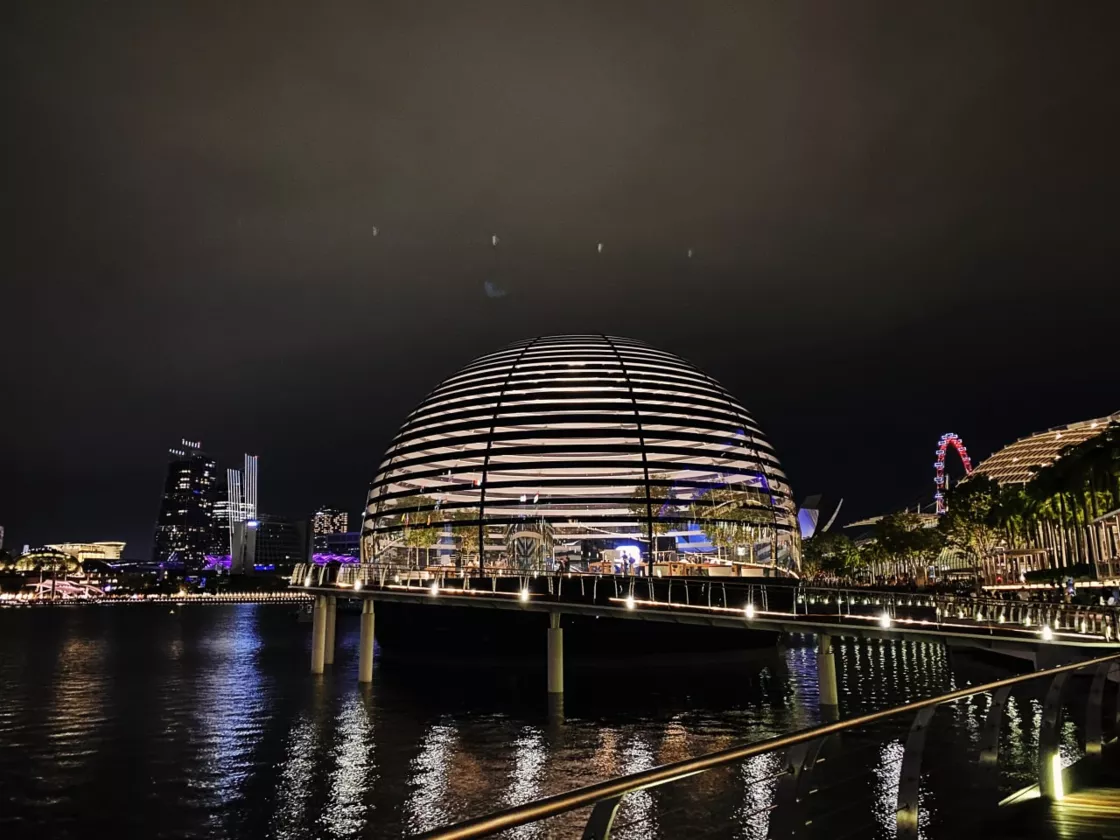 Apple Marina Bay Sands---
Apple Marina Bay Sands---
Fort Canning Park
📍 位置:围绕于 Hill Street, Canning Rise, Clemenceau Avenue 和 River Valley Road, Singapore 179618
💰 Tickets: Free
🚇 Transportation: Take SMRT to Fort Canning Exit B, Clarke Quay Exit E or Dhoby Ghaut Exit B
🔗 Official website: www.nparks.gov.sg/gardens-parks-and-nature/parks-and-nature-reserves/fort-canning-park
When I first came to Singapore, I caught a glimpse of the bustle of Orchard Road (https://www.visitsingapore.com.cn/see-do-singapore/places-to-see/orchard/) on my way home from Changi Airport, and I always wanted to set foot in the area. I've always wanted to see it. However, by the time I visited it, even after the government announced the lifting of the lockdown and the gradual restoration of social order, this most consumerist street in Singapore had lost its former glitz and glamour. This was a bit disappointing to me as I came with the intention of seeing consumerism, but it's not like there are no good places to go around, the historic Fort Canning Park being one of them.
Fort Canning Park is an important historical landmark in Singapore, first known as "Bukit Larangan", which means "Forbidden Hill" in Malay. It is located within Fort Canning Hill, in the heart of Singapore, a short walk down the hill to the famous Orchard Road shopping area, National Museum of Singapore (National Museum) is located at the back of Park Hill, connected by escalators. The Fook Hong Ning Hill area was once the centre of ancient Singapore which flourished in the 14th century, home to the King's palace, the Far East Command Centre and the headquarters of the British military barracks.
 Faulconing Park
Faulconing Park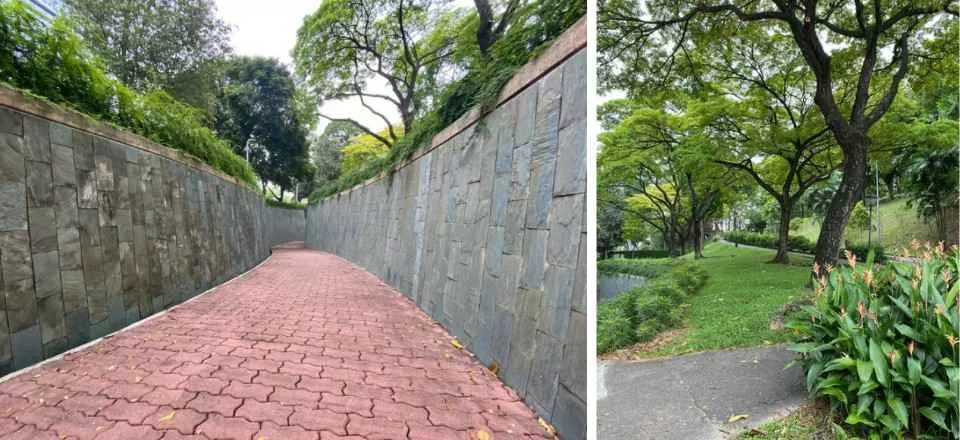 Inside Fokonnen Park Although Fokonnen Park has been rebuilt several times and even military buildings have been repaired, the vegetation on the entire hill is still lush and the natural landscape and The natural landscape and the artificial traces complement each other and together form the human landscape of this place.
Inside Fokonnen Park Although Fokonnen Park has been rebuilt several times and even military buildings have been repaired, the vegetation on the entire hill is still lush and the natural landscape and The natural landscape and the artificial traces complement each other and together form the human landscape of this place.
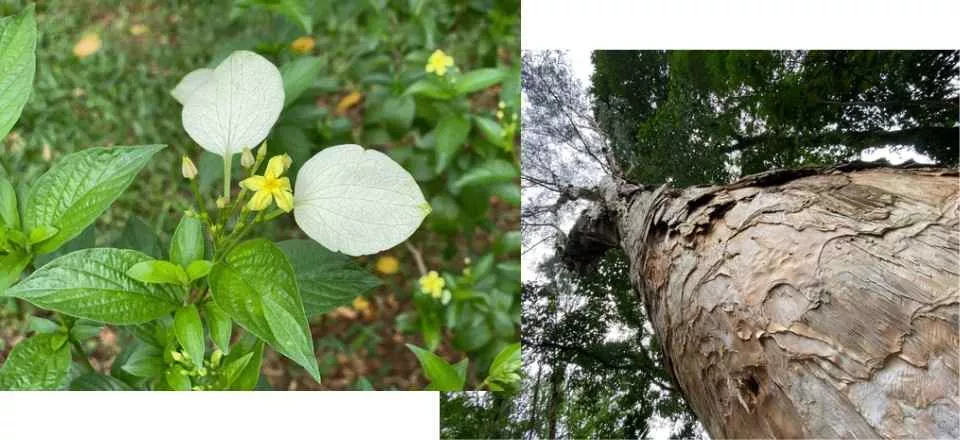 Park flowers and giant trees### Fort Canning Lighthouse
Park flowers and giant trees### Fort Canning Lighthouse
Walk out of Clarke Quay tube station and cross the road to the southeast entrance of Fort Canning Park. After a few turns along the path, you will come to Fort Canning Lighthouse. Fort Canning Lighthouse, also known as Fort Canning Light, is located at the top of Fort Canning Hill, formerly one of the 13 important lighthouses in the Straits of Malacca.
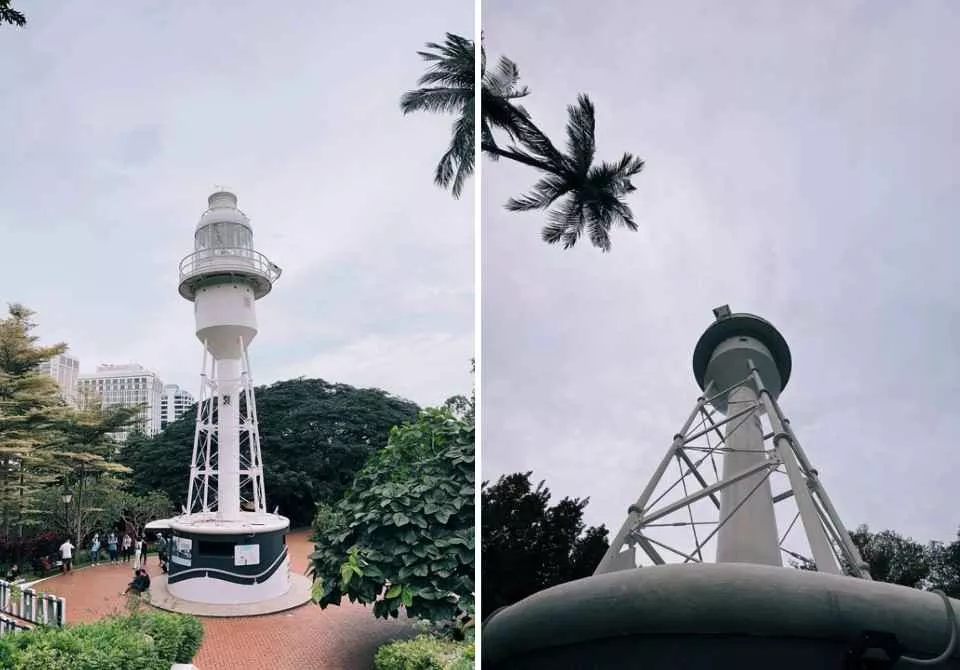 Faulconing Lighthouse### Raffles House
Faulconing Lighthouse### Raffles House
At the top of this hill, echoing the Faulconing Lighthouse is none other than Raffles House. Raffles House was the residence of Sir Raffles, the founder of modern Singapore, and the original building was a wooden structure that was later rebuilt as a neo-classical style Governor's House, which served as the residence of the later Colonial Governor. However, it was demolished again in 1858 to make way for the construction of Fort Canning. The existing structure built on the same site is a brick building constructed in 2003. The red-roofed, white-walled building can be viewed up close by walking all the way forward from the fountain at the entrance and picking up the steps under the flag-raising pole, and although you cannot enter it, you can see through the glass doors and windows that its interior is now empty and almost devoid of furnishings.
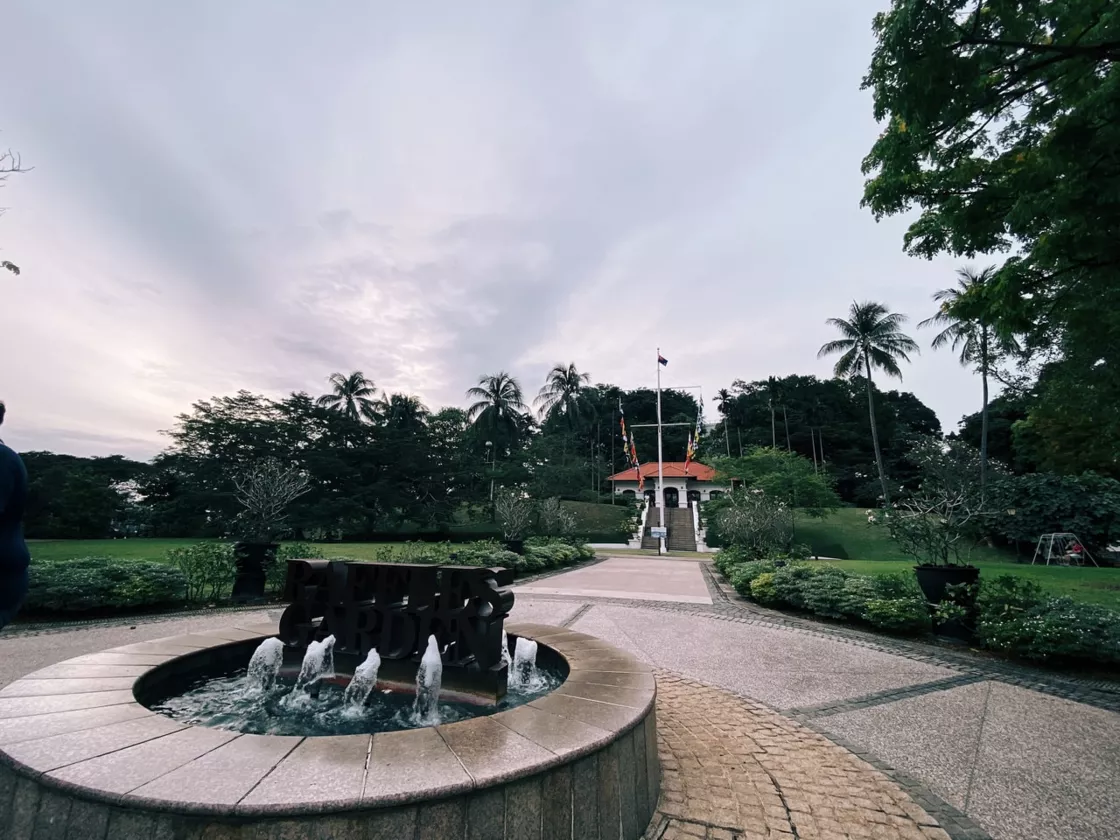 Raffles House### Sang Nila Utama Garden
Raffles House### Sang Nila Utama Garden
Continuing down the path by the Fook Hong Ning Lighthouse, you come to the Sang Nila Utama Garden. Sang Nila Utama Garden is named after Singapore's first ancient king Prince of Megaport. It was once part of the palace that stood on Fook Hong Ning Hill in the 14th century. The gardens are enclosed by a slightly taller-than-human red brick wall and contain a variety of flowering plants as well as exhibits of ancient artifacts. There are nine gardens in Faulconing Park, not just one, with different features and dates of construction, but mainly divided between modern and ancient, the latter surrounded by red brick walls. For example, the Forrbidden Spring, a feature of the Pancur Larangan gardens, is said to have been used by the ladies of the 14th century palace for bathing, and today visitors are allowed to bathe in a scaled-down version of the ancient Greek baths.
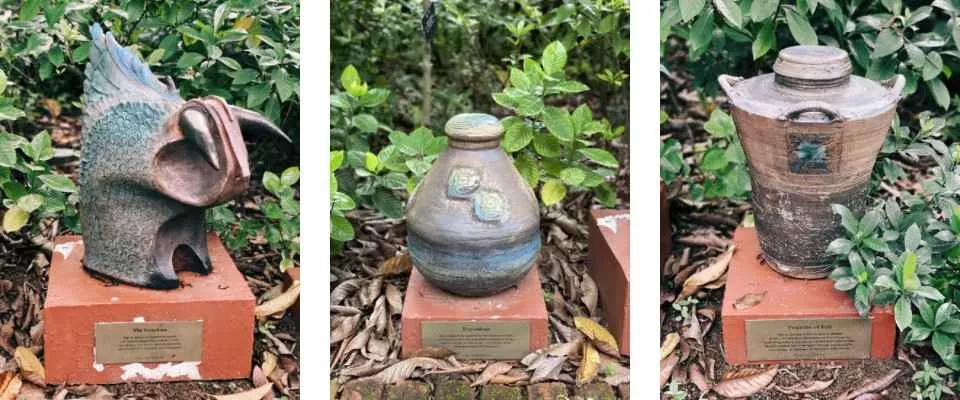 Garden Exhibits### Remains of the Fort
Garden Exhibits### Remains of the Fort
As you continue through the Sanni La Utama Gardens, you can see the traces of a number of military buildings, indicating that you have come to the boundaries of the remains of the fort. The remains of the fort, built in 1859, have since been demolished, leaving only the GC Collyer-designed Fort Gate and the two cannons (9-Pound Cannon). Today, the entire section of the wall is mottled and covered with moss and vines, leaving only the metal gates to maintain the monument's majesty due to regular maintenance.
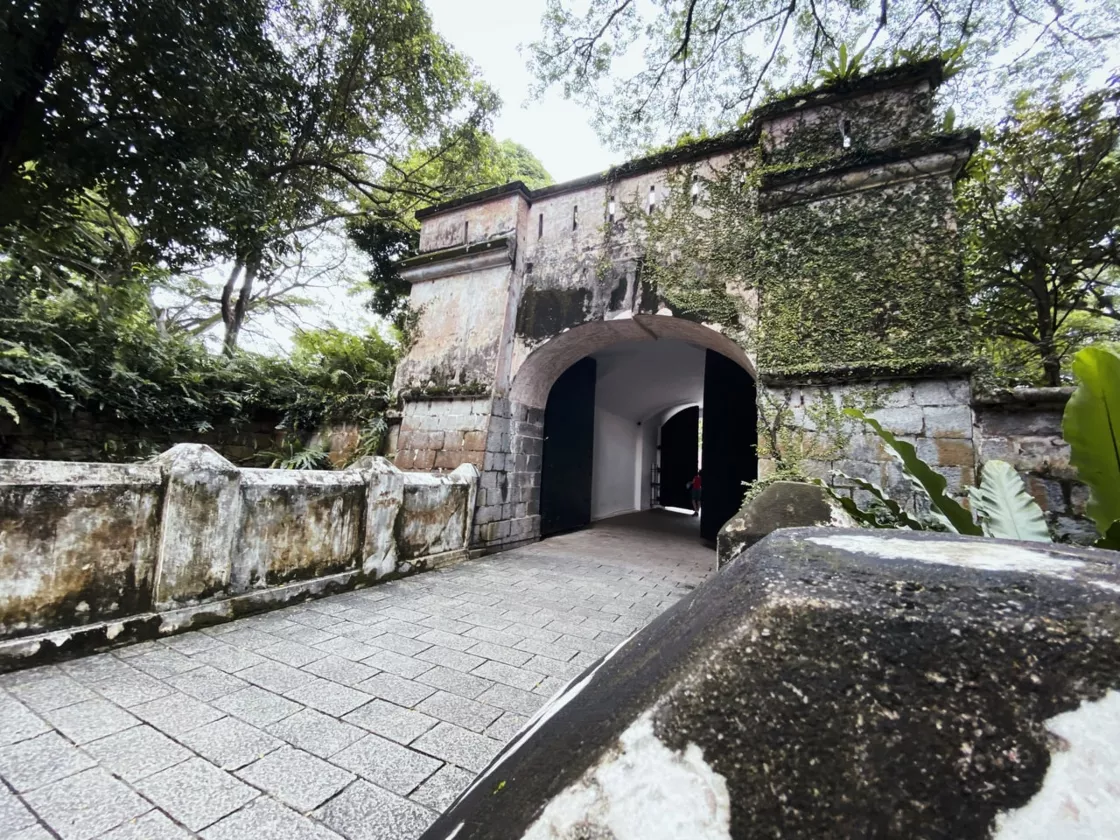 Fort Gate Fort Gate
Fort Gate Fort Gate
 A section of a low wall somewhere in the park that may be carved with local history### Fort Canning Park Tunnel Fort Canning Park Tree Tunnel
A section of a low wall somewhere in the park that may be carved with local history### Fort Canning Park Tunnel Fort Canning Park Tree Tunnel
Continue along the trail, bypassing the Faulconing Hotel to the northeast corner of the park. There is a spiral staircase at this point, which is a popular photo spot, and there was a line of people waiting to take photos from dawn to dusk. I joined the queue with the idea of "I'm here, I'm here", but I underestimated the enthusiasm of the people and waited from dawn to early light to conclude my visit to Faulconing.
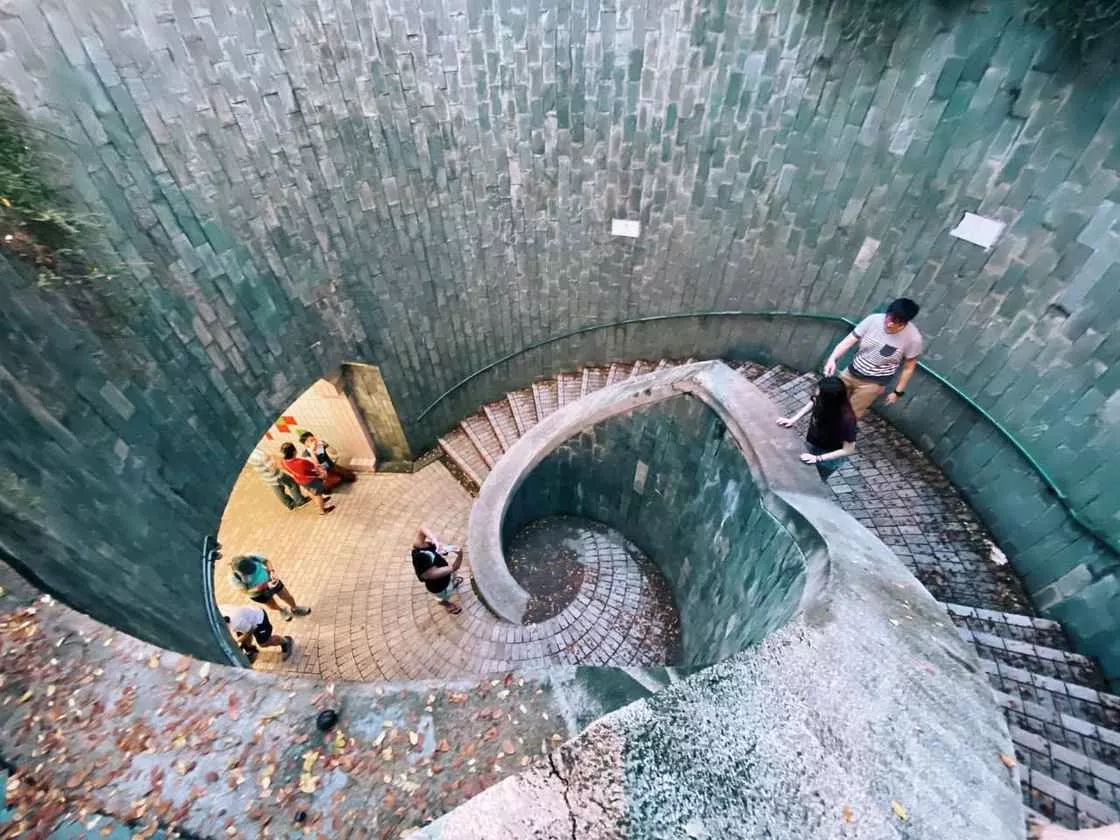
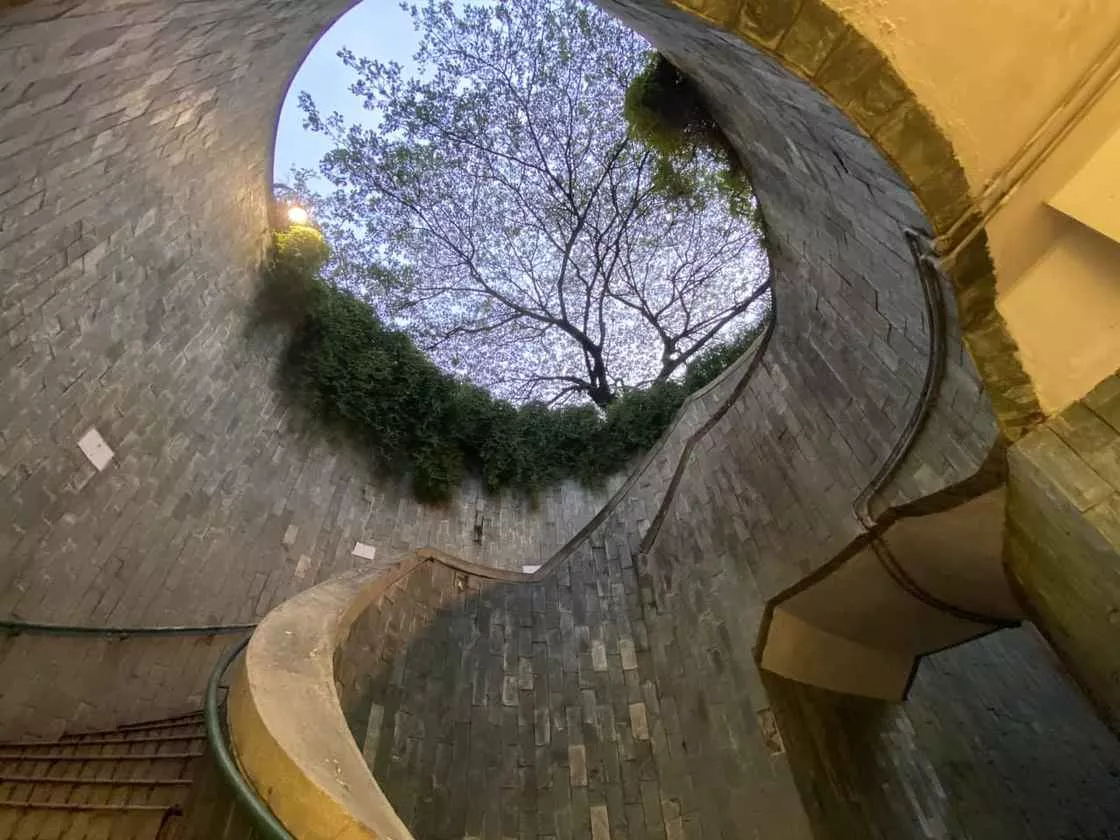 ---
---
Raffles Marina
📍 Location: 10 Tuas West Drive, Singapore 638404
💰 Tickets: Free
🚇 Transportation: Take the SMRT and get off at Tuas Link
🔗 Official website: https://www.rafflesmarina.com.sg/
Another impromptu excursion, only because Raffles Marina is not far from (Raffles Marina) where I live. Built in the mid-90s, Raffles Marina is a resort in the form of a modern marina and country club, known for its unique coastal scenery as well as its excellent dining and accommodation facilities. Entering through the gate, you walk through the red-roofed, white-walled accommodation and dining area to the marina, where the calm inner side of the breakwater is filled with a scattering of dinghies of all kinds.
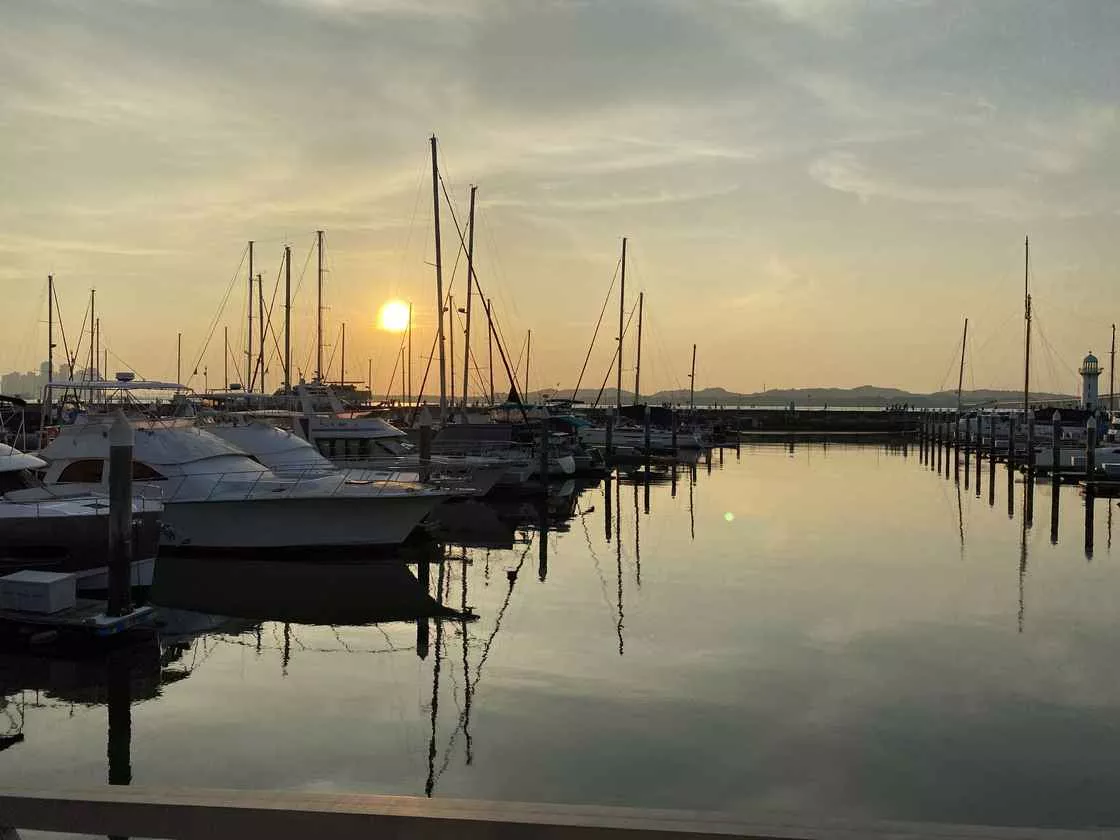
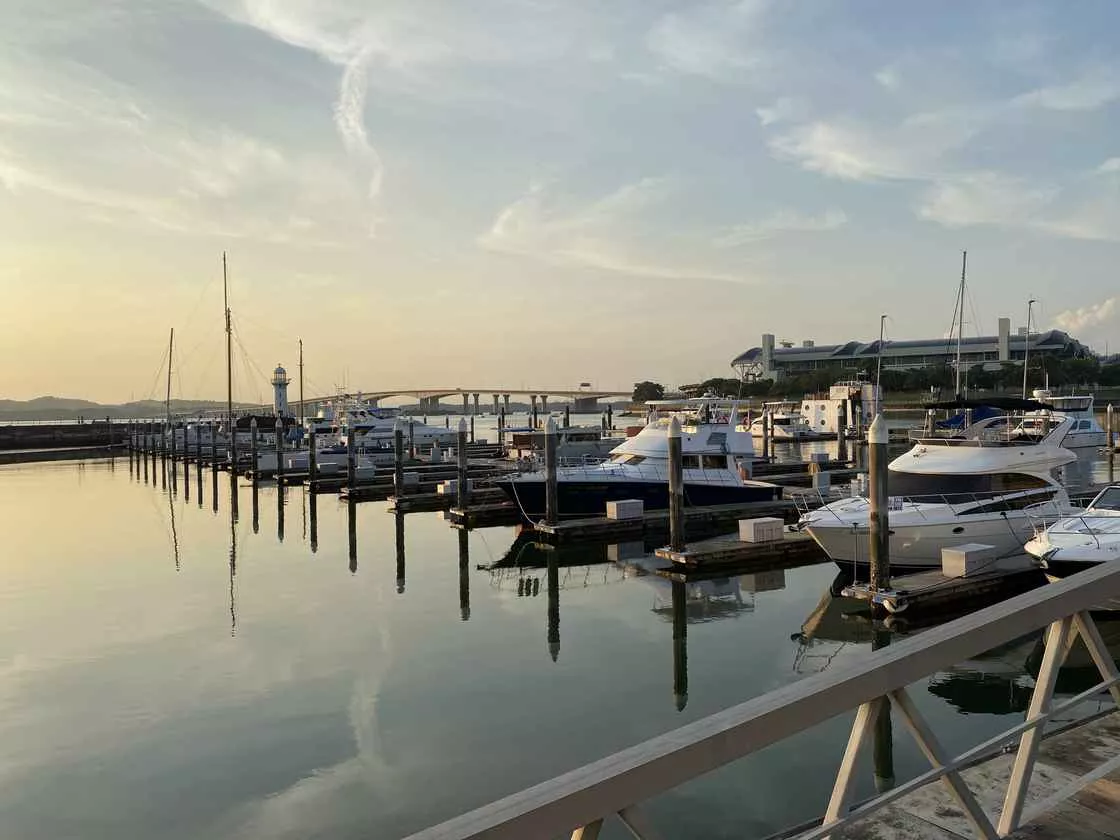
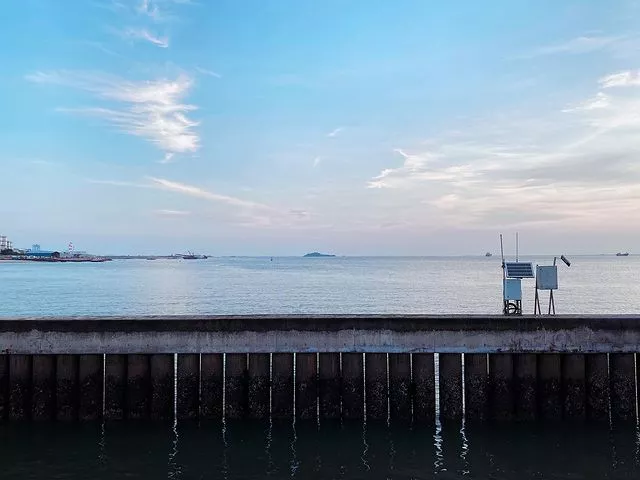
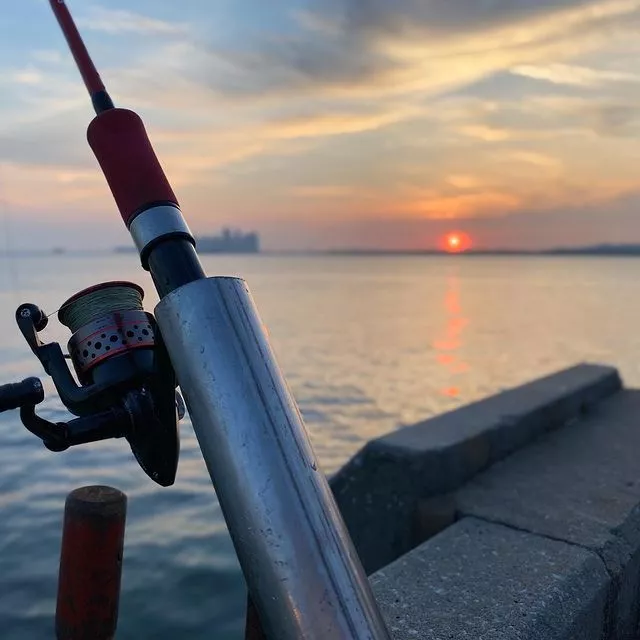 I wonder if the breakwater at Raffles Quay was designed to be long and folded for the convenience of tourists. On one side is a fence painted sky blue, while on the other side fishing pegs are set up every less than ten meters. A little further on, a sailing yacht with the words Panorama II is moored at the edge of the jetty. Compared to the small boats in the marina, which are only a few metres long, this 50-metre-long vessel with its tall mast can be considered a 'mammoth'. But it is dry and tidy, and the sails are tucked away, as if it has not been sailing for some time, a microcosm of the impact of the epidemic.
I wonder if the breakwater at Raffles Quay was designed to be long and folded for the convenience of tourists. On one side is a fence painted sky blue, while on the other side fishing pegs are set up every less than ten meters. A little further on, a sailing yacht with the words Panorama II is moored at the edge of the jetty. Compared to the small boats in the marina, which are only a few metres long, this 50-metre-long vessel with its tall mast can be considered a 'mammoth'. But it is dry and tidy, and the sails are tucked away, as if it has not been sailing for some time, a microcosm of the impact of the epidemic.
Raffles Marina Lighthouse Johor Straits Lighthouse
Walk to the end of the breakwater and you'll find the Johor Straits Lighthouse standing here. Built in 1994 at the top of the Raffles Marina breakwater, this 12m high lighthouse is one of the local internet sensations and a popular wedding venue. In the early evening, there were no less than three Instagrammers with their teams of fill-in lights taking photos, as well as families and couples. Standing on the breakwater and looking across the water, you can see the Malaysia-Singapore Second Link and Malaysia.
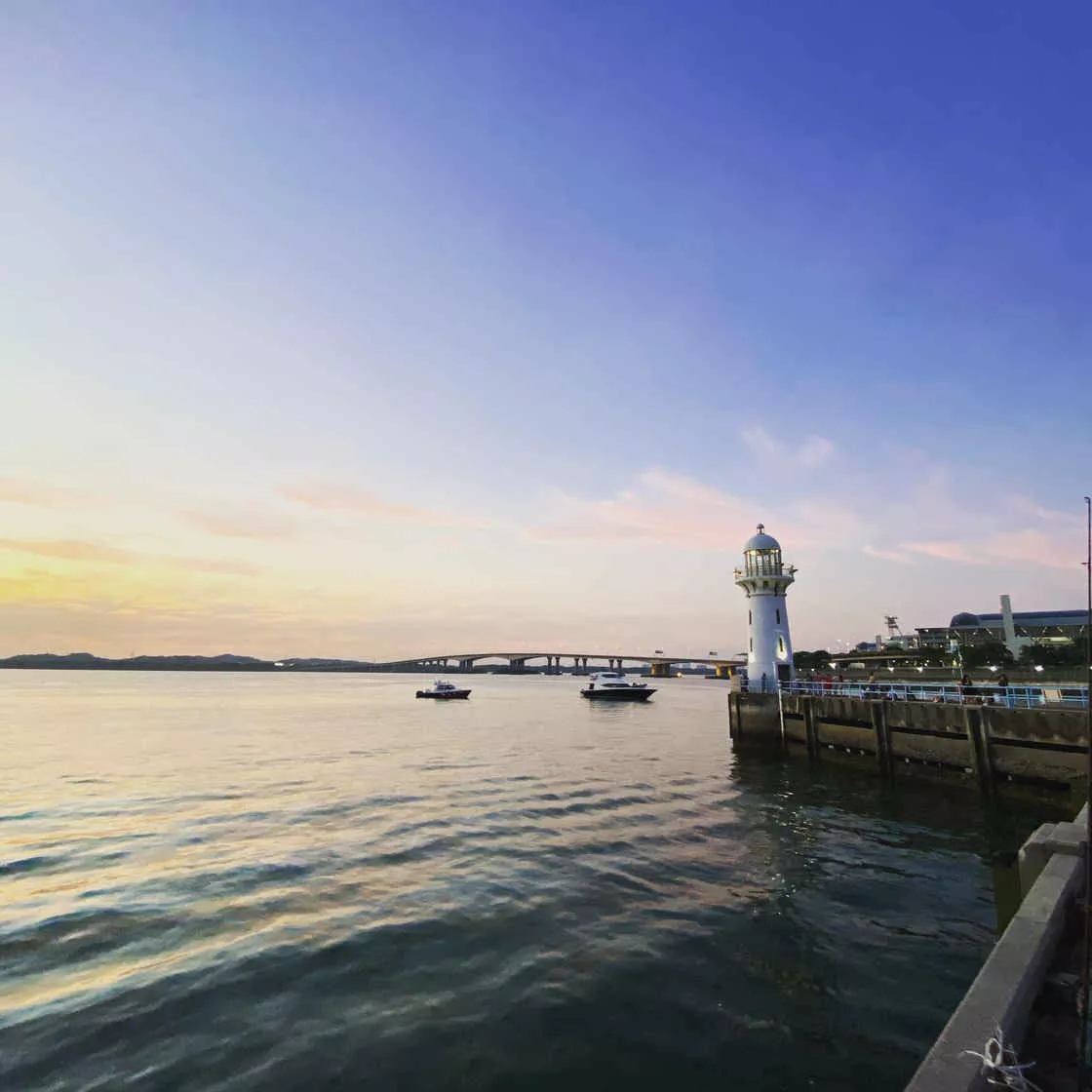
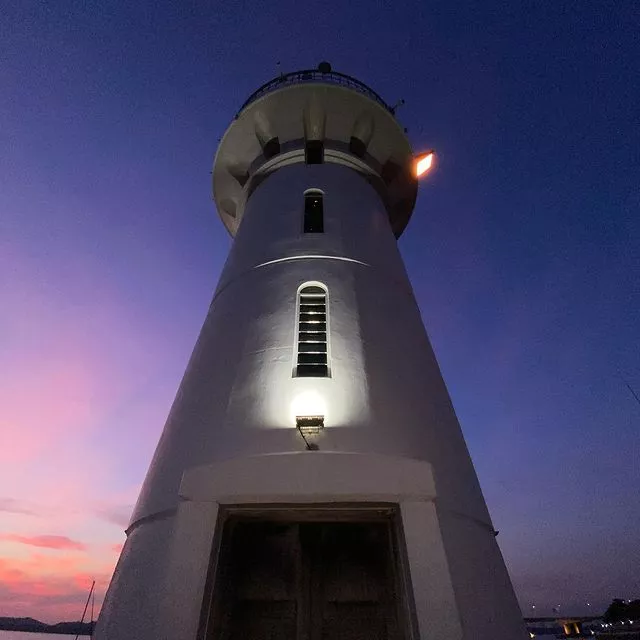 Postscript
Postscript
It is true that all the buildings, scenery and commercial facilities mentioned above are pleasant, but what impresses me most about the city is not here, but in the city, in the life.
Singapore's earliest history can only be traced back to the Malaysian period and some legends and stories, and there is a clear sense that it is not deep in cultural heritage. But there is a strong sense of 'newness' in their respect and preservation of what little history they have, and in the way the locals identify and feel confident in their own identity. They are making their own history.
Although Singapore is located in the tropics, the climate is pleasant, with temperatures ranging from 26 to 34 degrees Celsius year-round, warm and humid but not too hot. The life of the locals is leisurely, with the "Pasha" as the centre to form a neighbourhood gathering area, including restaurants, supermarkets, clinics and other essential living facilities, and the MRT station as the node to gather the nearby Pasha to form a comprehensive centre mainly for transportation and shopping. In the Chinese community, which is dominated by immigrants from Guangdong and Fujian, there is a Min-Cantonese attitude towards life. Even during the worst period of the epidemic, there were occasional complaints from the public, but people were still hopeful and happy in spite of the hardships.
In addition to being easily accessible, Singapore is also second to none in terms of accessibility, with barrier-free access and gentle ramps with handrails everywhere. In addition to this, the driver is required to get off the bus and lower the rear door flap to allow disabled passengers to push their wheelchairs on board. In addition, the government's care for the population is evident: many places throughout the island have long rain-proof promenades, which is rare for a country with an oceanic climate to be able to leave home without an umbrella.
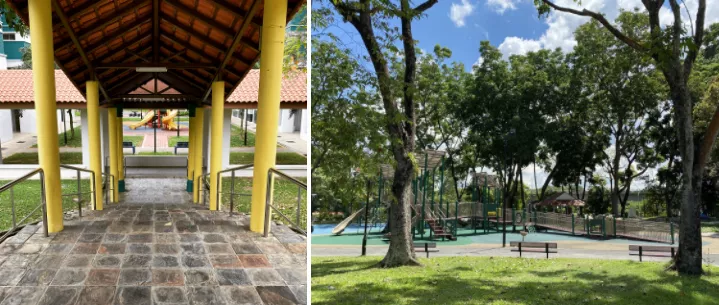 The rain sheltered promenade in the HDB area / The recreational playgrounds in the marketplaceOne of the most disconcerting aspects of the transient lifestyle may be the sound of engines roaring late every night. Singapore doesn't ban motorcycles, so there are often reports in the news of deaths caused by racing. In contrast, there are strict controls on electric vehicles. Since there are no non-motorized lanes in Singapore, the sidewalks are also bike lanes, and electric vehicles are classified as non-motorized, causing very many problems and accidents, and sparking heated debates in Parliament, and at one point, even considering banning them.
The rain sheltered promenade in the HDB area / The recreational playgrounds in the marketplaceOne of the most disconcerting aspects of the transient lifestyle may be the sound of engines roaring late every night. Singapore doesn't ban motorcycles, so there are often reports in the news of deaths caused by racing. In contrast, there are strict controls on electric vehicles. Since there are no non-motorized lanes in Singapore, the sidewalks are also bike lanes, and electric vehicles are classified as non-motorized, causing very many problems and accidents, and sparking heated debates in Parliament, and at one point, even considering banning them.
For me, Singapore is a city of details. It may be a thoughtful design on a public facility or a preserved tree on a wide avenue. This sense of consideration for others in the smallest detail is an experience not often found at home. Singaporeans emphasize cooperation, and this may be their way.
All images used in this article were taken by the author using an iPhone 11 Pro, unless otherwise noted.
© This article is copyrighted by the author and is licensed for exclusive use by Minority and may not be reproduced or used without Minority's permission.